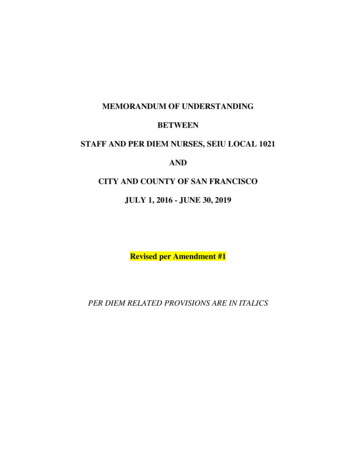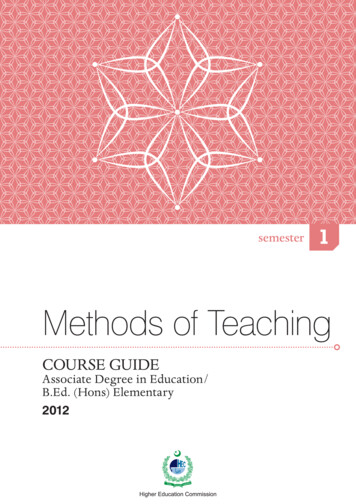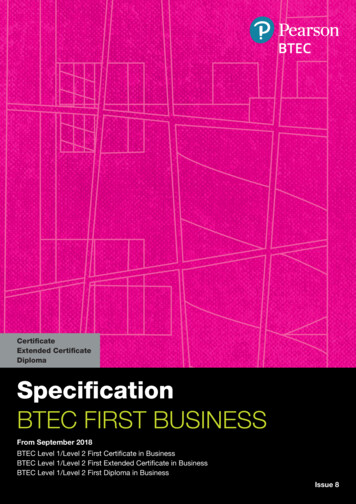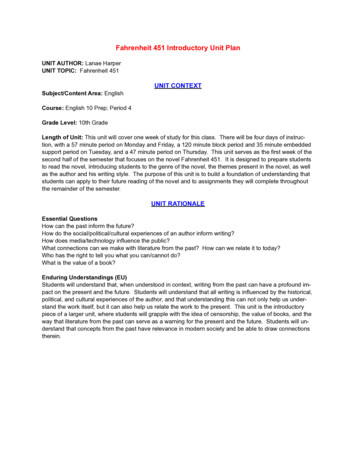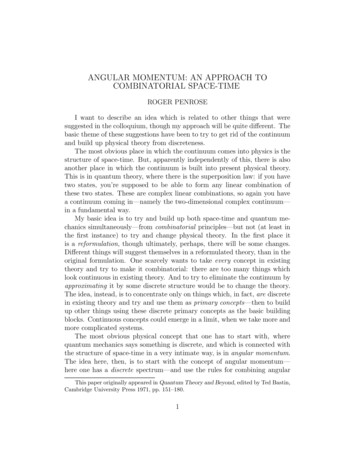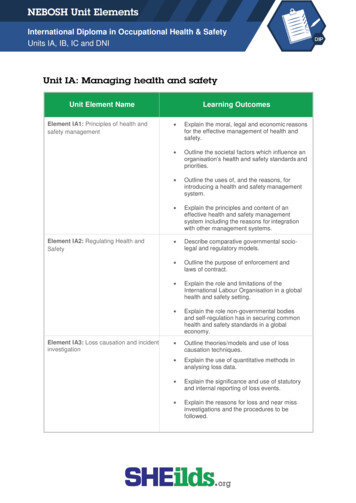
Transcription
International Diploma in Occupational Health & SafetyUnits IA, IB, IC and DNIUnit IA: Managing health and safetyUnit Element NameElement IA1: Principles of health andsafety managementLearning OutcomesExplain the moral, legal and economic reasonsfor the effective management of health andsafety.Outline the societal factors which influence anorganisation’s health and safety standards andpriorities.Outline the uses of, and the reasons, forintroducing a health and safety managementsystem.Explain the principles and content of aneffective health and safety managementsystem including the reasons for integrationwith other management systems.Element IA2: Regulating Health andSafetyDescribe comparative governmental sociolegal and regulatory models.Outline the purpose of enforcement andlaws of contract.Explain the role and limitations of theInternational Labour Organisation in a globalhealth and safety setting.Explain the role non-governmental bodiesand self-regulation has in securing commonhealth and safety standards in a globaleconomy.Element IA3: Loss causation and incidentinvestigationOutline theories/models and use of losscausation techniques.Explain the use of quantitative methods inanalysing loss data.Explain the significance and use of statutoryand internal reporting of loss events.Explain the reasons for loss and near missinvestigations and the procedures to befollowed.
International Diploma in Occupational Health & SafetyUnits IA, IB, IC and DNIElement IA4: Measuring and reviewinghealth and safety performanceExplain the purpose and use of performancemeasurement in relation to health and safetyobjectives and arrangements.Explain the need for, and the objectives andlimitations of, health and safety monitoring.Describe the variety of health and safetymonitoring and measurement techniques.Explain the need for and process of reviewinghealth and safety performance.Element IA5: The assessmentand evaluation of riskExplain how to use internal andexternal information sources inidentifying hazards and the assessingof risk.Outline the use of a range of hazardidentification techniques.Explain how to assess and evaluate riskand to implement a risk assessmentprogramme.Explain the analysis, assessment andimprovement of system failures andsystem reliability with the use ofcalculations.Explain the principles and techniques offailure tracing methodologies with the useof calculations.Element IA6: Risk controlExplain the use of common risk managementstrategies.Outline factors to be taken into accountwhen selecting risk controls.Explain the development, main featuresand operation of safe systems of workand permit-to-work systems.
International Diploma in Occupational Health & SafetyUnits IA, IB, IC and DNIElement IA7: Organisational factorsExplain the types of health and safetyleadership, their advantages; disadvantagesand likely impact on safety performance.Explain the organisational benefitsof effective health and safetyleadership.Explain the internal and external influences onhealth and safety in an organisation.Outline the different types of organisation,their structure, function and the concept ofthe organisation as a system.Explain the requirements for managingthird parties in the workplace.Explain the role, influences on andprocedures for formal and informalconsultation with workers in the workplace.Explain health and safety culture and climate.Outline the factors which can both positivelyand negatively affect health and safety cultureand climate.Element IA8: Human factorsOutline psychological and sociologicalfactors which may give rise to specificpatterns of safe and unsafe behaviour in theworking environment.Explain the nature of the perception of riskand its relationship to performance in theworkplace.Explain the classification of human failure.Explain appropriate methods of improvingindividual human reliability in the workplaceExplain how organisational factors cancontribute to improving human reliability.Explain how job factors can contribute toimproving human reliability.Outline the principles, conditions and typicalcontent of behavioural change programmesdesigned to improve safe behaviour in theworkplace.
International Diploma in Occupational Health & SafetyUnits IA, IB, IC and DNIElement IA9: The role of the health andsafety practitionerExplain the role of the health and safetypractitioner.Explain the importance of effectivecommunication and negotiation skills whenpromoting health and safety.Outline how health and safety practitionerscan use financial justification to aid decisionmaking.Outline the different types of organisation, theirstructure, function and the concept of theorganisation as a system.Explain the requirements for managing thirdparties in the workplace.Explain the role, influences on and proceduresfor formal and informal consultation withemployees in the workplace.Explain health and safety culture and climate.Outline the factors which can both positivelyand negatively affect health and safety cultureand climate.
International Diploma in Occupational Health & SafetyUnits IA, IB, IC and DNIUnit IB: Hazardous substances / agentsUnit Element NameElement IB1: Managingoccupational healthElement IB2: Identification, assessmentand evaluation of hazardous substancesLearning Outcomes Outline the nature of occupational health. Outline the principles and benefits of themanagement of return to work including therole of outside support agencies. Outline the management of occupational health(including the practical and legal aspects). Outline the uses of, and the reasons, forintroducing a health and safety managementsystem. Explain the principles and content of aneffective health and safety managementsystem including the reasons for integrationwith other management systems. Explain the main routes of entry and the humanbody’s defensive responses to hazardoussubstances. Explain the identification, classification andhealth effects of hazardous substances used inthe workplace. Outline the factors to consider whenundertaking assessment and evaluation of risksfrom hazardous substances. Outline the role of epidemiology andtoxicological testing.
International Diploma in Occupational Health & SafetyUnits IA, IB, IC and DNIElement IB3: The control of hazardoussubstancesElement IB4: The monitoring andmeasuring of hazardous substancesElement IB5: Biological agentsElement IB6: Noise and vibration Explain the principles of prevention and controlof exposure to hazardous substances(including carcinogens and mutagens). Outline the specific requirements for workingwith asbestos. Explain the uses and limitations of dilutionventilation and the purpose and operation oflocal exhaust ventilation, including assessingand maintaining effectiveness. Explain the effectiveness of various types ofpersonal protective equipment (PPE) and thefactors to consider in selection of PPE. Explain how workplace exposure limits areused in the workplace. Outline the methods for sampling of airbornecontaminants. Outline the principles of biological monitoring. Explain the types and properties of biologicalagents found at work. Explain the assessment and control of risk fromdeliberate and non-deliberate exposure tobiological agents at work. Explain the basic physical concepts relevant tonoise. Explain the effects of noise on the individualand the use of audiometry. Explain the measurement and assessment ofnoise exposure. Explain the principles and methods ofcontrolling noise and noise exposure. Explain the basic physical concepts relevant tovibration. Explain the effects of vibration on theindividual. Explain the measurement and assessment ofvibration exposure. Explain the principles and methods ofcontrolling vibration and vibration exposure.
International Diploma in Occupational Health & SafetyUnits IA, IB, IC and DNIElement IB7: RadiationElement IB8: Mental ill-health anddealing with violence and aggression atworkElement IB9: Musculoskeletal risksand controlsElement IB10: Work environmentrisks and controls Outline the nature of the different types ofionising and non-ionising radiation. Explain the effects of exposure to non-ionisingradiation, its measurement and control. Outline the effects of exposure to ionisingradiation, its measurement and control. Outline the different sources of lasers found inthe workplace, the classification of lasers andthe control measures. Explain the principles and methods ofcontrolling vibration and vibration exposure. Explain the effects and causes of commontypes of mental ill-health within the workplace. Explain the identification and control ofworkplace mental ill-health with reference tolegal duties and other standards. Explain the scope, effects and causes of workrelated violence/aggression. Explain the identification and control of workrelated violence/aggression with reference tolegal duties. Outline types, causes and relevant workplaceexamples of injuries and ill-health conditionsassociated with repetitive physical activities,manual handling and poor posture. Explain the assessment and control of risksfrom repetitive activities, manual handling andpoor posture. Explain the need for, and factors involved in,the provision and maintenance of temperaturein both moderate and extreme thermalenvironments. Explain the need for suitable and sufficientlighting in the workplace, units of measurementof light and the assessment of lighting levels inthe workplace. Explain the need for welfare facilities andarrangements in fixed and temporaryworkplaces. Explain the requirements and provision for firstaid in the workplace.
International Diploma in Occupational Health & SafetyUnits IA, IB, IC and DNIUnit IC: Workplace and work equipment safetyUnit Element NameElement IC1: Workplace welfarerequirements and specific workplaceissuesElement IC2: Fire and explosionLearning Outcomes Explain the need for, and factors involved in,the provision and maintenance of a safeworking environment. Explain the hazards, risks and controlmeasures associated with work in confinedspaces. Outline the main issues associated withmaintaining structural safety of workplaces. Explain the hazards, risks, and controls whenworking at height. Explain the hazards, risks and controls for loneworking. Outline the properties of flammable andexplosive materials and the mechanisms bywhich they ignite. Outline the behaviour of structural materials,buildings and building contents in a fire. Outline the main principles and practices ofprevention and protection against fire andexplosion.Element IC3: Workplace Fire RiskAssessmentExplain the processes involved in theidentification of hazards and theassessment of risk from fire.Describe common fire detection and alarmsystems and procedures.Describe the factors to be considered whenselecting fixed and portable fire-fightingequipment for the various types of fire.Outline the factors to be considered inproviding and maintaining the means ofescape. Explain the purpose of, and essentialrequirements for, emergency evacuationprocedures.
International Diploma in Occupational Health & SafetyUnits IA, IB, IC and DNIElement IC4: The storage, handling andprocessing of dangerous substancesElement IC5: Work equipmentElement IC6: Workplace machinery Outline the main physical and chemicalcharacteristics of industrial chemicalprocesses. Outline the main principles of the safe storage,handling and transport of dangeroussubstances. Outline the main principles of the design anduse of electrical systems and equipment inadverse or hazardous environments. Explain the need for emergency planning, thetypical organisational arrangements needed foremergencies and relevant regulatoryrequirements. Outline the criteria for the selection of suitablework equipment for particular tasks andprocesses to eliminate or reduce risks. Explain how risks to health and safety arisingfrom the use of work equipment are controlled. Explain safe working procedures for themaintenance, inspection and testing of workequipment according to the risks posed. Explain the role of competence, training,information and supervision in the control ofrisks arising from the installation, operation,maintenance and use of work equipment. Outline the maintenance and preventionstrategies when working with pressuresystems. Outline the principles of safety integration andthe considerations required in a generalworkplace machinery risk assessment. Outline the principal generic mechanical andnon-mechanical hazards of general workplacemachinery. Outline the main types of protective devicesfound on general workplace machinery. Explain the principles of control associated withthe maintenance of general workplacemachinery. Explain the key safety characteristics ofgeneral workplace machinery control systems.
International Diploma in Occupational Health & SafetyUnits IA, IB, IC and DNIElement IC7: Mobile, lifting, access andwork at height equipmentElement IC8: Electrical safetyElement IC9: Construction and worksof a temporary nature – hazards andcontrolsElement IC10: Workplace transport andmanaging work-related road risk Outline the main hazards and control measuresassociated with mobile work equipment. Outline the main hazards and control measuresassociated with lifting equipment. Outline the main hazards and control measuresassociated with access equipment andequipment for working at height. Outline the basic concepts of electricity. Outline the hazards of electricity and staticelectricity. Outline the issues relevant to the installation,use, inspection and maintenance of electricalsystems. Outline the main principles for safe working inthe vicinity of high voltage systems. Outline the main hazards, risks and controlsassociated with the use of portable electricalequipment. Outline the scope and nature of constructionactivities. Explain the scope and application of theConstruction (Design and Management)Regulations 2015 and associated guidance. Explain the appropriate site control measuresthat should be adopted to protect employeesand others during construction work. Outline the hazards and control measuresassociated with working at height from fixedwork or temporary platforms. Explain the hazards and control measures,associated with demolition work. Explain the hazards and control measuresassociated with excavation work. Outline the factors to be considered in aworkplace transport risk assessment and thecontrols available for managing workplacetransport risk. Outline the role and purpose of a work-relatedroad risk policy and the key components of awork-related road traffic safety managementsystem.
International Diploma in Occupational Health & SafetyUnits IA, IB, IC and DNIUnit DNI: Application of health and safety management inthe workplaceAreaDescriptionAim of the DNI Assignment Students demonstrate their competency andunderstanding gained from the study of UnitsA, B and C, based on a practical workplacesituation.Materials Covered The assignment unit DNI contains no additionalcontent.Assignment Brief Students are required to perform a review ofthe existing systems for managing health andsafety in a workplace. Students will then provide theirrecommendations to justify proportionaterecommendations in an aim to improveperformance. The assignment must be carried out in thestudent’s workplace. Where no access to a suitable workplace isavailable, the accredited course providershould be consulted to assist in this regard. Both the student and the employer should bemade aware the report of Unit DNI is foreducational purposes only. Students can submit their DNI assignmentreport in the months of February, May, Augustand November. The assignment is submitted directly toNEBOSH electronically for marking.Assignment LocationAssignment Submission
International Diploma in Occupational Health & Safety Units IA, IB, IC and DNI Unit IA: Managing health and safety Unit Element Name Learning Outcomes Element IA1: Principles of health and safety management Explain the moral, legal and economicreasons for the effective management of health and safety. Outline the societal factors which influence an




